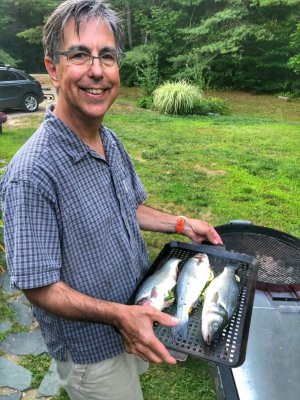I was very happy with how these 1lb Branzini came out. Serves 3 as a main dish or 6 as an appetizer. (A one-pound whole fish only has about a half pound of meat.)
Start by building up a good bed of coals in your charcoal grill, with most of the coals on one side, creating a cool side and a hot side.
Slather the fish inside and out with salt, pepper, and olive oil. In the cavity put a couple of lemon slices and a handful of fresh parsley, fresh oregano, and fresh chervil, or the fresh herb mix of your choice. (Go easy if using rosemary.) I put more lemon slices underneath the fish - between them and the grill tray I'm holding in the pic. Set aside.
While the fire is settling down, shuck three ears of very fresh corn. Spray them lightly with a neutral fat of your choice - e.g., canola oil.
Put the corn on the cool side of the grill and cover. Check the corn every two or three minutes, turning as needed, and moving closer to the hotter side of the grill as needed. You want some toasty brown spots but a minimum of black char. They should be done in about 10 minutes. Remove the corn and set aside at room temperature.
Spread out the coals so they are even. Put the fish on and cover the grill. Cook 8-10 minutes per side. The grill thermometer should be registering about 500F.
While the fish are cooking, cut the kernels off the cooked corn and place in a medium sized mixing bowl. Add two large fresh garden tomatoes, in small dice. Add some generous glugs of best virgin olive oil, about a teaspoon of white wine vinegar, salt, freshly ground pepper, and a handful of fresh basil chiffonade. Adjust vinegar and oil to taste.
Once done, the outsides of the fish were pretty charred, so I just spatula'd out skinless and (nearly) boneless cooked filets. The bones on these fish are large, so pulling the spine out was trivial. I served each diner one filet to start, with more fresh chervil and colorful dashes of hot sauce on top. On the same plate I put a generous helping of the corn/tomato salad. Eating some of the salad in the same bite with the fish is ideal.



 www.norwayexports.no
www.norwayexports.no

